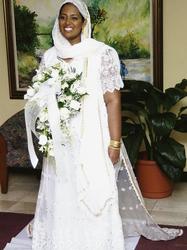Sacha Walters, Staff Reporter 
No matter the religion or culture, there's still something about seeing a bride wearing white, as Cherrida McBean proved at her wedding held at the Hilton Kingston hotel, Knutsford Boulevard, New Kingston, on August 11, 2006. - Winston Sill/Freelance Photographer
One of the most important days in aperson's life is his or her wedding day. It ranks high up there with graduations, buying your first house and the birth of a child. While the nervousness and frustration are similar for most, the wedding ceremony takes a different spin in most religions. While all religions cannot be assessed, we'll look at two - Buddhist and Hindu cultures.
According to www.marriage. aryabhatt.com, in Buddhism, marriage is not a prerequisite of the religion. It is a secular tradition which is done by choice. But there are a number of practices which have developed out of Asian and Buddhist traditions. Many Buddhist marriages in Asia are arranged. A wedding broker makes the match between the bride and groom and both of the families will visit each other without the children and assess their potential. After a couple of visits, including one with an astrologer, the couple meets and eventually gives their confirmation.
Dowry
When they arrive at a dowry, the astrologer will indicate the best date for the wedding. During the days before the wedding, the couple might invite monks into their home to pray and use holy water to bless the house and read from the Tipitaka (Buddhist holy book). After the monks complete their blessing, the grooms offer them gifts to bring good luck.
The ceremony itself can be held in a local temple where both ask for the blessing of Buddha. The couple then dresses in their traditional clothes. If the bride is Japanese, she can change her outfit up to four times during the ceremony. Her first outfit will be a white kimono to represent her willingness to adopt the groom's family. During this time her head should be covered to hide jealousy. Then she wears a Western-style gown. This is followed by a multi-coloured kimono called a furisode and finally a Western ball gown.
The Japanese groom will wear a black kimono with a white one underneath. He may also wear a short kimono coat called an haori with crests or haori cords on top of the white kimono. The crests represent the groom's ancestry. This is worn with white split-toe socks called tabi and sandals with white thongs called zori.
The religion does not necessarily require using the temple's shrine or even monks. Wherever the ceremony is being held, there will be a shrine with a statue of Buddha and candles, flowers and incense. There are no traditional vows, but they recite from the Sigilovdda Sutta. After they recite the words, they exchange rings, and if monks are present, they further the ceremony by chanting.
The couple finally has a large feast to welcome their guests.
Hindu Weddings
The Hindu celebrations begin weeks before the actual wedding. According to Inger Persaud, a 37-year-old who lives in Trinidad and Tobago, she and her husband fasted for one week before the ceremony. During this time, they did not eat meat or drink alcohol. "We were not allowed to meet during this time," Inger said. The pundit/priest selects the appropriate date. She said it almost always happens either on a Friday or Sunday, as according to the patra (book of dates) these are good dates, not Saturdays.
"Two nights before the actual date for the ceremony our skins are rubbed with Hurdi, a yellow powder which grows similar to the ginger plant." She said it helps with cleaning the skin and they were not allowed to bathe. In addition, they could not consume anything with salt. "We drank milk for these two days," she added.
On the night before the wedding, which is called the Matticor night, elderly ladies sing Hindi songs. "Mainly rude songs depicting the wedding night," she added, "That was fun."
On the day of the wedding, they both bathe and say prayers before dressing.
"The groom always comes to the bride's home for the ceremony. When his entourage arrives, the two fathers meet in the road and embrace to confirm the acceptance of the marriage. The groom remains in the car until the acceptance is finalised," Inger said. Tassa drummers are usually playing during this time.
"Before leaving home and while in the car, he (the groom) must touch his mother's bosom for the last time as a sign he is moving into manhood," she said. The groom's mother remains at home during the ceremony. "She cannot witness the marriage of her son. She has to wait to receive her new daughter-in -law and son after the ceremony."
The pundit sends for the bride, who is covered in her mother's orni, a head covering which signifies that she has agreed to the ceremony. She changes into three different-coloured saris for the different stages of the ritual. "White is purity, yellow the changing into a different path, and finally, red, a sign of joy," Inger said.
"During the ceremony when the bride changes into the red sari, there is a part called Kitchiri. Since the groom has been fasting for some time, a bowl is placed in front of the groom and monetary gifts are given by the girl's friends and family. Food is also placed in front of the groom and only when he eats do the gifts stop. This is all fun," she said.
The couple must arrive at the bride's mother-in-law's home before 6:00 p.m. Before they can go to their home, the new bride must spend a week at her mother-in-law's home. "This ritual is really to mould the new bride into finding out what her husband likes to eat according to his mother," Inger said.

